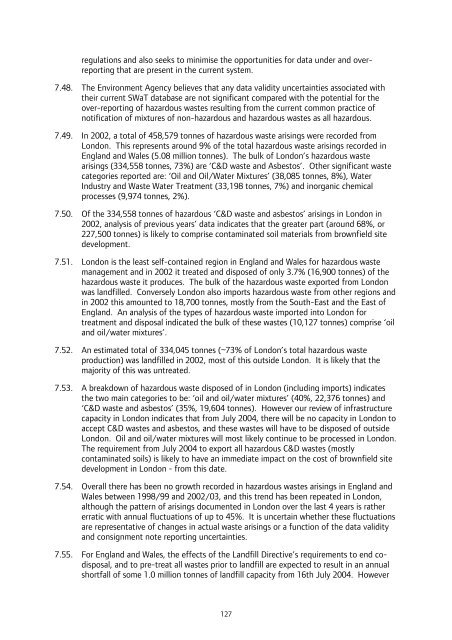London Wider Waste Strategy - London - Greater London Authority
London Wider Waste Strategy - London - Greater London Authority
London Wider Waste Strategy - London - Greater London Authority
Create successful ePaper yourself
Turn your PDF publications into a flip-book with our unique Google optimized e-Paper software.
egulations and also seeks to minimise the opportunities for data under and overreporting<br />
that are present in the current system.<br />
7.48. The Environment Agency believes that any data validity uncertainties associated with<br />
their current SWaT database are not significant compared with the potential for the<br />
over-reporting of hazardous wastes resulting from the current common practice of<br />
notification of mixtures of non-hazardous and hazardous wastes as all hazardous.<br />
7.49. In 2002, a total of 458,579 tonnes of hazardous waste arisings were recorded from<br />
<strong>London</strong>. This represents around 9% of the total hazardous waste arisings recorded in<br />
England and Wales (5.08 million tonnes). The bulk of <strong>London</strong>’s hazardous waste<br />
arisings (334,558 tonnes, 73%) are ‘C&D waste and Asbestos’. Other significant waste<br />
categories reported are: ‘Oil and Oil/Water Mixtures’ (38,085 tonnes, 8%), Water<br />
Industry and <strong>Waste</strong> Water Treatment (33,198 tonnes, 7%) and inorganic chemical<br />
processes (9,974 tonnes, 2%).<br />
7.50. Of the 334,558 tonnes of hazardous ‘C&D waste and asbestos’ arisings in <strong>London</strong> in<br />
2002, analysis of previous years’ data indicates that the greater part (around 68%, or<br />
227,500 tonnes) is likely to comprise contaminated soil materials from brownfield site<br />
development.<br />
7.51. <strong>London</strong> is the least self-contained region in England and Wales for hazardous waste<br />
management and in 2002 it treated and disposed of only 3.7% (16,900 tonnes) of the<br />
hazardous waste it produces. The bulk of the hazardous waste exported from <strong>London</strong><br />
was landfilled. Conversely <strong>London</strong> also imports hazardous waste from other regions and<br />
in 2002 this amounted to 18,700 tonnes, mostly from the South-East and the East of<br />
England. An analysis of the types of hazardous waste imported into <strong>London</strong> for<br />
treatment and disposal indicated the bulk of these wastes (10,127 tonnes) comprise ‘oil<br />
and oil/water mixtures’.<br />
7.52. An estimated total of 334,045 tonnes (~73% of <strong>London</strong>’s total hazardous waste<br />
production) was landfilled in 2002, most of this outside <strong>London</strong>. It is likely that the<br />
majority of this was untreated.<br />
7.53. A breakdown of hazardous waste disposed of in <strong>London</strong> (including imports) indicates<br />
the two main categories to be: ‘oil and oil/water mixtures’ (40%, 22,376 tonnes) and<br />
‘C&D waste and asbestos’ (35%, 19,604 tonnes). However our review of infrastructure<br />
capacity in <strong>London</strong> indicates that from July 2004, there will be no capacity in <strong>London</strong> to<br />
accept C&D wastes and asbestos, and these wastes will have to be disposed of outside<br />
<strong>London</strong>. Oil and oil/water mixtures will most likely continue to be processed in <strong>London</strong>.<br />
The requirement from July 2004 to export all hazardous C&D wastes (mostly<br />
contaminated soils) is likely to have an immediate impact on the cost of brownfield site<br />
development in <strong>London</strong> - from this date.<br />
7.54. Overall there has been no growth recorded in hazardous wastes arisings in England and<br />
Wales between 1998/99 and 2002/03, and this trend has been repeated in <strong>London</strong>,<br />
although the pattern of arisings documented in <strong>London</strong> over the last 4 years is rather<br />
erratic with annual fluctuations of up to 45%. It is uncertain whether these fluctuations<br />
are representative of changes in actual waste arisings or a function of the data validity<br />
and consignment note reporting uncertainties.<br />
7.55. For England and Wales, the effects of the Landfill Directive’s requirements to end codisposal,<br />
and to pre-treat all wastes prior to landfill are expected to result in an annual<br />
shortfall of some 1.0 million tonnes of landfill capacity from 16th July 2004. However<br />
127
















